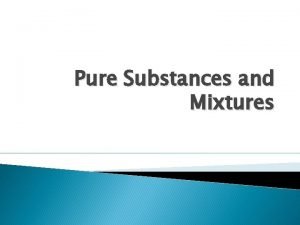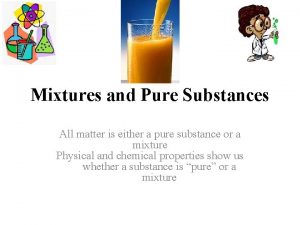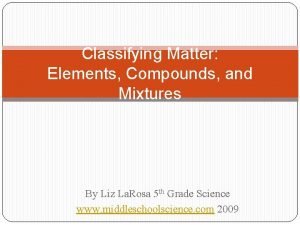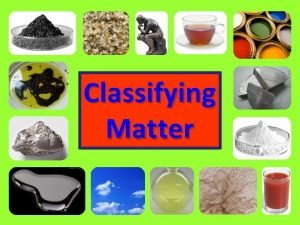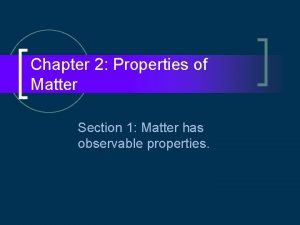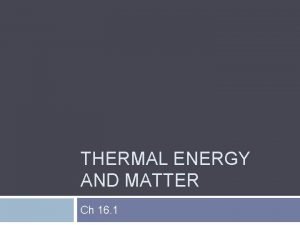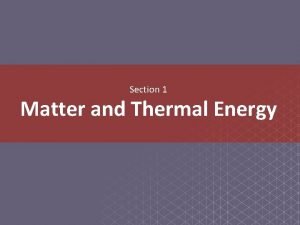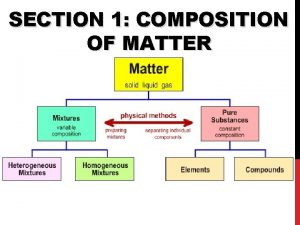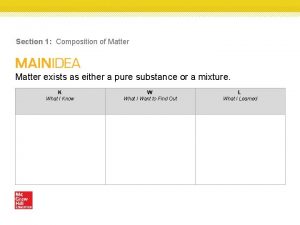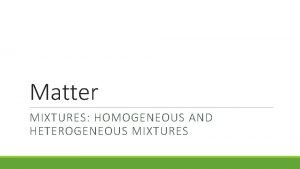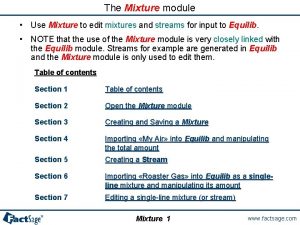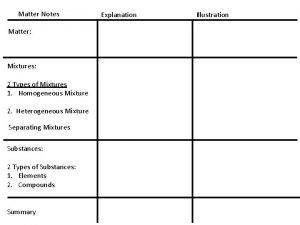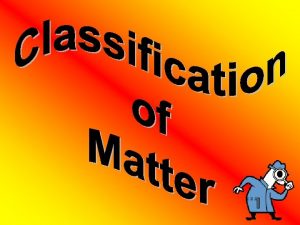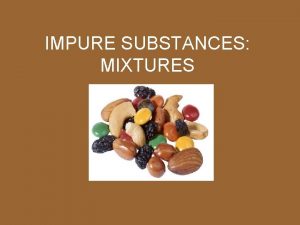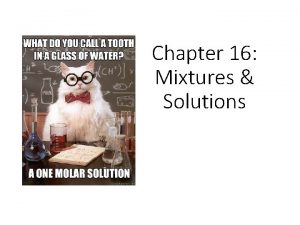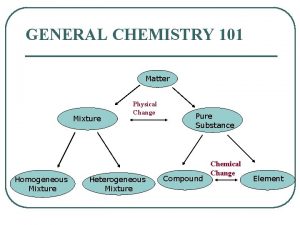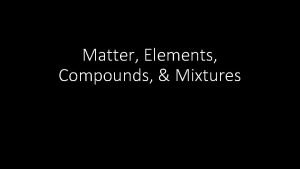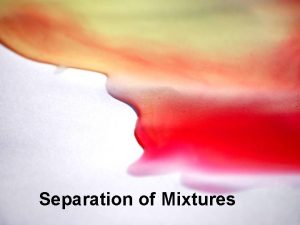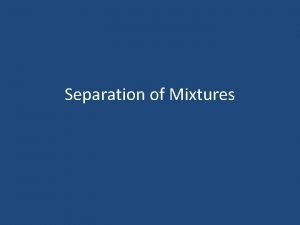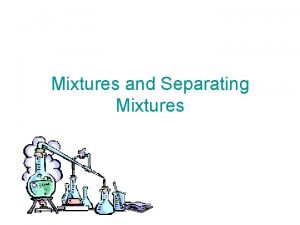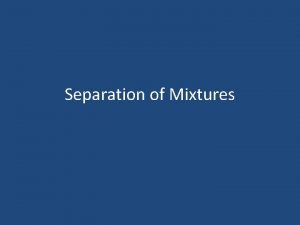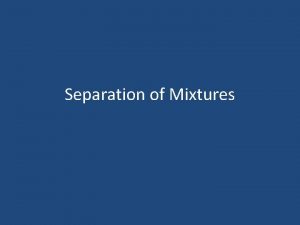Section 3 MIXTURES OF MATTER Mixtures A mixture


























- Slides: 26

Section 3 MIXTURES OF MATTER

Mixtures • A mixture is a combination of two or more pure substances in which each pure substance retains its individual chemical properties. • Most everyday substances are mixtures.

• The composition of mixtures varies • This makes a mixture different from a compound. Compounds always have the same composition, whereas the composition of mixtures varies. – Example: The air

• Mixtures can be separated into pure substances Mixtures Two or more pure substances

Heterogeneous Mixture • A mixture containing regions with differing properties. A mixture that does not blend smoothly throughout and in which the individual substances remain distinct.

Homogeneous Mixtures • A mixture that has a constant composition throughout • Homogeneous mixtures referred to as solutions. Solutions can be an any state of matter. – Example: • Liquid Salt Water • Gas Air in a scuba tank • Solid Alloy

Alloy • An alloy is a mixture of elements that have metallic properties. 12 Carat Gold Ring 18 Carat Gold Ring

SEPARATING MIXTURES

Filtration • Separation of a solid from a liquid by using a filter paper

Distillation • A separation process that depends on the different boiling points of the substances.

Crystallization • A separation technique that results in the formation of pure solid particles of a substance from a solution containing the dissolved substance.

Sublimation • Mixtures can be separated by a process where a solid changes into a water without melting.

Chromatography • A technique that separates the components of a mixture dissolved in either a gas or a liquid (called the mobile phase) based on the ability of each component to travel or to be drawn across the surface of a fixed substrate (called the stationary phase).


Section 4 ELEMENTS & COMPOUNDS

Elements • Elements are pure substances that cannot be separated into simpler substances by physical or chemical means.


Atoms • Matter is composed of tiny particles, which we call atoms.

Compounds • Compounds are made up of two or more different elements that are combined chemically. • Most matter in the universe exists in the form of compounds. • Compounds always have the same composition A Salt (Na. Cl) Molecule

Molecules • A molecule is made up of atoms that are “stuck” together. • For example: A glass of water contains a huge number of molecules packed closely together.

Law of Definite Proportions • States that a compound is always composed of the same elements in the same proportion by mass, no matter how large or small the sample. • The mass of the compound is equal to the sum of the masses of the elements that make up that compound.

Percent by Mass •

How Do I Find the Mass of an Element or Compound? ? ? • Answer: The Periodic Table • The mass of an element = Atomic Mass • The mass of a compound = the addition of each component element in the compound

Practice w/ Percent Mass • A 78. 0 g sample of unknown compound contains 12. 4 g of hydrogen. What is the percent mass of hydrogen in the compound? – 15. 9% • 1. 0 g of hydrogen reacts completely with 19. 0 g of fluorine. What is the percent by mass of hydrogen in the compound that is formed? – 5. 0%

Law of Multiple Proportions • States that when different compounds are formed by a combination of the same elements, different masses of one element combine with the same fixed mass of the other element in a ratio of small whole numbers. • Ratios compare the relative amounts of any items or substances. • The ratios express the relationship of elements in a compound.

Analysis Data of Two Copper Compounds Compound % Cu % Cl Mass Cu (g) in 100. 0 g of compound Mass Cl (g) in 100. 0 g of compound I 64. 20 35. 80 II 47. 27 52. 73
 Classification of matter section 1 composition of matter
Classification of matter section 1 composition of matter Classification of matter section 1 composition of matter
Classification of matter section 1 composition of matter Chapter 2 section 1 classifying matter answer key
Chapter 2 section 1 classifying matter answer key Composition of matter section 1
Composition of matter section 1 Is 14 karat gold homogeneous or heterogeneous
Is 14 karat gold homogeneous or heterogeneous Soil is a mixture of weathered rock and
Soil is a mixture of weathered rock and Graphic organizer of mixture
Graphic organizer of mixture Mixture graphic organizer
Mixture graphic organizer A mechanical mixture
A mechanical mixture Classifying elements compounds and mixtures
Classifying elements compounds and mixtures Matter is classified by
Matter is classified by Grey matter of nervous system
Grey matter of nervous system What makes up the diencephalon
What makes up the diencephalon Gray matter and white matter
Gray matter and white matter Ncl caudatus
Ncl caudatus Flow of energy vs flow of matter
Flow of energy vs flow of matter Section 3 cycling of matter
Section 3 cycling of matter Chapter 2 properties of matter
Chapter 2 properties of matter Chapter 10 review states of matter section 4
Chapter 10 review states of matter section 4 Which reverses the normal flow of thermal energy
Which reverses the normal flow of thermal energy Section 1 matter and thermal energy
Section 1 matter and thermal energy Section 1 composition of matter
Section 1 composition of matter Section 1 composition of matter answer key
Section 1 composition of matter answer key Principles of ecology organisms and their relationships
Principles of ecology organisms and their relationships Principles of ecology section 3 cycling of matter
Principles of ecology section 3 cycling of matter Chapter 2 section 3 cycling of matter answer key
Chapter 2 section 3 cycling of matter answer key Hidden lines are not generally omitted in a sectional view
Hidden lines are not generally omitted in a sectional view






